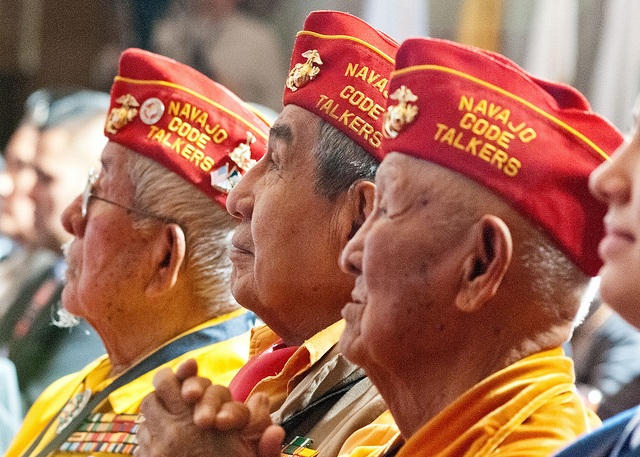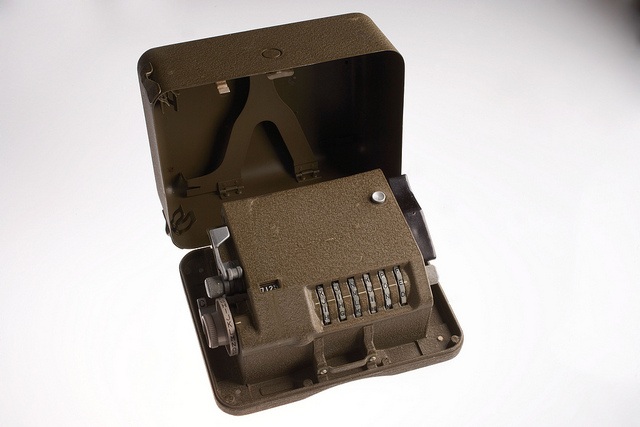All About Code

Navajo Code Talkers at the U.S. Department of the Interior in 2012
Activity from IEEE’s TryEngineering. Click HERE for PDF of the whole activity.
Summary
Students in grades 3 – 5 learn how alphanumeric symbols can be encoded for many fun purposes. In the first of two sessions, they learn about codes by making their own with a limited number of symbols. They then attempt to break each other’s codes and discover the relationship among encryption, decryption, and shared keys.
Grade level: 3-5
Time: Two 1-hour sessions
Learning outcomes
- Simple codes, including binary and Unicode/ASCII.
- How simple symmetric encryption/decryption works.
- How any symmetric code can be broken.
- Encryption schemes such as Cipher Wheels the Enigma Machine.
- That any code can be broken with good information and a lot of time.
- The relationship between encryption and decryption
- How security is a constant game of cracking the code.
- CONTENT STANDARD E: Science and Technology As a result of activities, all students should develop an understanding about science and technology. (K-8)
- Practice 2: Generating and Using Models. Use a model to test cause and effect relationships or interactions concerning the functioning of a natural or designed system. (K-4)
- Principles and Standards for School Mathematics: Problem Solving. Solve problems that arise in mathematics and in other contexts Connections; Recognize and apply mathematics in contexts outside of mathematics( grades 5-8)
- Nature of Technology, Standard 2: Students will develop an understanding of the core concepts of technology
- The Designed World, Standard 17: Students will develop an understanding of and be able to select and use information and communication technologies
Materials

M-209 cipher machine used by the U.S. Army in World War II
- Access to the Internet to watch the videos listed under Internet Connections.
- The student resource pages shown below
- A pair of dice to create random numbers
- Scissors, enough to easily share
- Clear tape
Internet Connections
Procedure
This lesson explores both simple and more complex cipher systems. It also introduces binary numbers as a code. Because the experience is for elementary students with a potentially wide range of arithmetic expertise, the activities are kept very simple and hands on. Session 1 explores simple codes, using binary numbers as an initial example.
Cipher Wheels and Enigma are then introduced, and students are given the challenge of creating a code, and instructions for deciphering it. Please be prepared to demonstrate the following in Session 1:
The simplest kind of code involves shifting the letters a specified amount to the left or right. The key, in this instance is not the strip, but number of letter and whether it is a left or a right shift. Demonstrate this with a cipher strip from the Student Resource page.
Students may decide to create a cipher wheel. They can attach the two ends of a cipher strip to create a physical wheel. By using multiple strips they can shift the letters in more complex ways. Have an example handy to demonstrate.
Session 2 allows students to try to break each others’ codes, and wraps up with a video that opens the door to more complicated encryption techniques.
Session 1
- Show the binary number video most appropriate for your class. At most, spend 10 minutes discussing how binary numbers work.
- Distribute Worksheet 1, on page 6 of 9 (Click HERE for PDF) and have pairs of students complete the worksheet.
- Show the Jefferson Cipher Wheel and Enigma videos and discuss how the wheels can be viewed as strips of paper that are looped. Using your prepared samples, demonstrate how place shifting and wheels work.
- As a group, brainstorm some ways to use the cipher strips, and take the opportunity to encourage imaginative solutions. Encryption – All About Code Page 3 of 9 Developed by IEEE as part of TryEngineering www.tryengineering.org
- Distribute Worksheet 2, on page 7 (click HERE for PDF) and help pairs of students create interesting codes. Make sure they write down their key. Remind them to write their name on each worksheet. As pairs complete this task, assign them another pair of students to swap messages. Collect everyone’s Worksheet 2 to refer to in Session 2.
Session 2
- Distribute students’ Worksheet 2. Have them create another coded message. This time have them hand off the message to someone without the key, challenging them to break each other’s codes. Give help as needed, and as students break codes, have them help others as well. Consider offering a prize to the students who break the most codes, and whose codes weren’t broken. Allow students whose code was broken to create another one. Limit this activity to approximately an hour.
- Gather your students together for a discussion. On a white or black board create a list of all the different keys and whether they could be broken or not. Ask students to reflect on what it was about the keys that made them easy or hard.
- Watch the public/private encryption video. Discuss why this extra layer is necessary for security. Challenge your students to poke holes in the algorithm: how could things go wrong.
- This can be done in a single two-hour session if your students are typically cooperative during group activities.
Optional Writing Activity
Filed under: Class Activities, Grades K-5, Grades K-5, Lesson Plans
Tags: Class Activities, code, coding, computation, computer, Computer Engineering, Cybersecurity, data privacy, encryption, Grades K-5, IEEE, Lesson Plan, password








